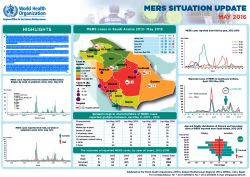 Situation update on Middle East respiratory syndrome coronavirus, August 2017
Situation update on Middle East respiratory syndrome coronavirus, August 2017
- At the end of August 2017, a total of 2080 laboratory-confirmed cases of Middle East respiratory syndrome coronavirus (MERS-CoV), including 739 associated deaths (case–fatality rate: 35.5%) were reported globally; the majority of these cases were reported from Saudi Arabia (1710 laboratory-confirmed cases, including 665 related deaths with a case–fatality rate of 38.9%).
- During the month of August 2017, two clusters of MERS were reported from the same city in Al-Jawf Region of Saudi Arabia which were not epidemiologically related. Up to 31 August 2017, a total of 13 cases, including one related death (index case), were reported from the first cluster which was reported from a hospital. Of these, 10 cases were asymptomatic, including 8 health care workers. The 2 remaining cases were symptomatic and were household contacts of index case. The second cluster occurred in the community with 6 cases reported out of which 4 household contacts were asymptomatic. The date of onset of last laboratory-confirmed case from the hospital cluster was 10 August 2017, and since then no new cases were reported from this cluster. The date of onset of the last laboratory-confirmed case from the second cluster (in the community) was 29 August 2017.
- The demographic and epidemiological characteristics of the cases reported in 2017 do not show any significant difference compared with cases reported during the same period from 2012 to 2016. Owing to improved infection prevention and control practices in the hospitals, the number of hospital-acquired cases of MERS has dropped significantly in 2015 and in 2016 compared to previous years. However, recently the number of hospital-acquired cases has increased.
- The age group of those aged 50–59 years continues to be the group at highest risk for acquiring infection as primary cases. For secondary cases, it is the age group of 30–39 years who are mostly at risk. The number of deaths is higher in the age group of 50–59 years for primary cases and 70–79 years for secondary cases.








